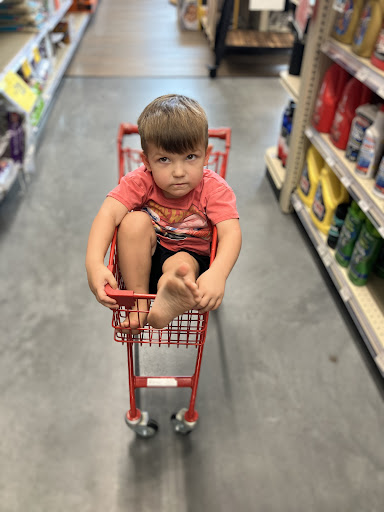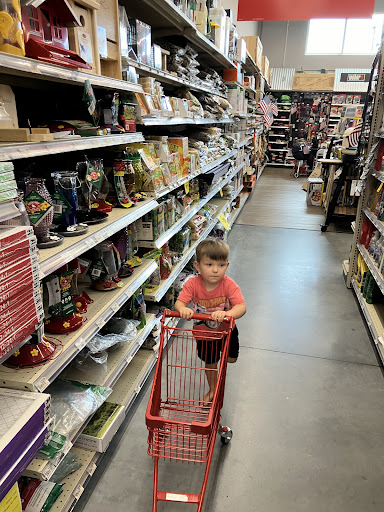Why the Right Rig Matters
Using live bait is a key to success when fishing inshore for species like redfish and speckled trout. Choosing the right inshore live bait rigs makes all the difference in getting strikes, as a natural presentation entices even the wariest fish.
The most effective inshore live bait rigs for saltwater fishing are:
- Carolina Rig (or Fish Finder Rig): Best for presenting bait on the bottom.
- Popping Cork Rig: Ideal for suspending bait over oyster rakes or grass beds.
- Freeline Rig: Perfect for shallow, calm water, allowing bait to swim naturally.
- Knocker Rig: Great for fishing close to structure like docks and pilings.
Mastering these rigs helps you adapt to different fishing conditions, depths, and target species. The helpful team at Lowcountry Ace brings years of practical experience in perfecting inshore live bait rigs for the Lowcountry’s unique waters, helping anglers of all levels achieve success.
Gearing Up: Essential Components for Tying Inshore Rigs
Before tying specific inshore live bait rigs, you need the right terminal tackle. Having the proper hooks, leader material, sinkers, and swivels is crucial for a strong and effective setup. Our Fishing Supplies Lowcountry Ace section is packed with everything you’ll need.
Choosing the Right Hooks and Leader Material
Your hook and leader are your direct connection to the fish.
For hooks, Circle Hooks are our top pick. They are designed to set in the corner of a fish’s mouth, which is ideal for catch-and-release. J-Hooks require a more forceful hook set and carry a higher chance of gut-hooking a fish.
A golden rule: match your hook size to your bait size, not the fish you’re targeting. A hook that’s too large makes bait look unnatural, while one that’s too small may not secure a solid hook-up. For more tips, check out our guide on fishing baits.
For leader material, Monofilament is a popular, budget-friendly choice that holds knots well. For clear water and spooky fish, Fluorocarbon is a stealthier, more abrasion-resistant option. A good tip is to use a leader that’s slightly weaker than your main line, so if you get snagged, you only lose your rig.
Selecting Sinkers and Swivels
Sinkers and swivels play a huge role in your rig’s performance.
Sinkers get your bait to the proper depth. The type and weight depend on the rig and conditions.
- Egg sinkers slide on the line, making them great for Carolina Rigs.
- Pyramid sinkers dig into the bottom, ideal for holding bait in strong currents. You can learn more about Pyramid sinkers if you’re curious.
- Split shot weights are small and easy to pinch onto your line for minor adjustments.
- Bank sinkers are bell-shaped and work well for general bottom fishing.
When choosing sinker weight, use the lightest weight possible that still gets your bait to the right depth and keeps it there.
Swivels prevent line twist and act as a connection point between your main line and leader. Barrel swivels are the most common, while Ball bearing swivels offer superior rotation for baits that spin a lot.
The Top 4 Inshore Live Bait Rigs for Saltwater Success
Now that your tackle is sorted, let’s dive into the inshore live bait rigs that excel in our Lowcountry waters. From James Island’s creeks to the Folly Beach flats, the right rig is essential. Each rig is designed for different situations, depths, and target species.
Here’s a quick look at what each rig brings to the table:
| Rig Name | Target Depth | Best For | Complexity |
|---|---|---|---|
| Carolina Rig | Bottom | Redfish, Flounder, Snook, Speckled Trout, Sheepshead (bottom feeders); sandy bottoms, grass flats, rock formations, near structures; allowing bait to drift naturally. | Medium |
| Popping Cork Rig | Suspended (shallow to mid-depth) | Speckled Trout, Redfish, Snook (active feeders); over oyster rakes, grass beds, shallow water, covering territory. | Medium |
| Freeline Rig | Surface to Mid-Depth | Snook, Bluefish, Tarpon, Speckled Trout (surface feeders, spooky fish); shallow, calm water, minimal current; natural bait movement. | Low |
| Knocker Rig | Bottom (near structure) | Drum, Snapper, Sheepshead, Snook (structure-oriented fish); docks, pilings, jetties; precise casting, compact presentation. | Low |
The Carolina Rig (Fish Finder Rig)
The Carolina Rig is a superstar for bottom fishing. It’s our go-to for targeting fish on the seabed.
How It Works: An egg sinker slides on your main line, followed by a bead and a swivel. The swivel connects to a leader with a hook. This setup lets a fish take the bait without feeling the sinker’s weight, leading to more confident bites. It’s a proven winner for redfish, flounder, and speckled trout.
Advantages: Natural presentation, great sensitivity, and versatile.
Disadvantages: Can snag on rough bottoms and is best for fishing a specific spot.
The Popping Cork Rig
When fish are active near the surface or over structure, the Popping Cork Rig is your secret weapon.
How It Works: A special popping cork is attached to your main line. A quick twitch of the rod makes the cork “pop,” mimicking a struggling baitfish and attracting predators like speckled trout and redfish. Your live bait hangs on a leader below the cork, keeping it just above snags like oyster beds.
Advantages: Attracts fish from a distance, prevents snags, covers water effectively, and provides a clear bite signal.
Disadvantages: Can spook fish in calm water and can be awkward to cast in wind.
The Freeline Rig: The Simplest Inshore Live Bait Rig
Sometimes, simple is best. The Freeline Rig offers the most natural presentation possible.
How It Works: This rig is just a hook tied to the end of your leader (or main line). There are no weights or floats, allowing your live bait to swim completely freely. It’s incredibly effective for wary snook, tarpon, and trout in shallow, calm water.
Advantages: Ultimate natural and stealthy presentation, very sensitive, and easy to tie.
Disadvantages: No depth control, limited casting distance, and not ideal for strong currents.
The Knocker Rig
The Knocker Rig is a great choice for getting bait down fast and keeping it tight to structure.
How It Works: An egg sinker is threaded directly onto your leader so it rests (“knocks”) against the hook’s eye. This compact setup allows for precise casting next to pilings, docks, and rocks. It’s excellent for structure-oriented fish like sheepshead, drum, and snapper.
Advantages: Direct feel for bites, compact design prevents tangles, and great for fishing tight to structure.
Disadvantages: Less natural bait movement, can snag, and wary fish might feel the weight.
You can find components for the knocker rig and other essential fishing gear for sale at Lowcountry Ace.
Advanced Techniques and Common Mistakes to Avoid
Mastering inshore live bait rigs goes beyond tying knots. Perfecting your bait presentation and avoiding common pitfalls will help you reel in more fish. For more ways to optimize your setup, check out our guide on fishing reels and rods.
Perfecting Hook Placement for Natural Movement
The way you hook live bait dramatically affects its movement. A natural presentation is more likely to trigger a strike.
Here are some effective hooking methods:
- Dorsal Hooking (Behind the Dorsal Fin): Allows bait to swim naturally; great for slow-trolling or drifting.
- Nose Hooking (Through the Nostrils or Horn): Encourages a natural, forward-swimming motion; excellent for free-lining.
- Throat Hooking: Causes the bait to swim deep; good for targeting fish on the bottom.
- Anal Fin Hooking (In Front of Anal Fin): Makes the bait swim away and down; a gentle tug creates a panicked darting action.
- Anal Vent Hooking (Through Anal Vent and Out Side): Creates a panicked, wobbling action that can trigger strikes but reduces bait lifespan.
Adapting Your Rig to the Bait
Tailor your inshore live bait rigs to the specific bait you’re using to maximize its appeal.
- Shrimp: Hook through the horn for a natural look, or through the tail for better casting and scent release.
- Baitfish (Mullet, Pinfish, etc.): Hook behind the dorsal fin for natural swimming, or through the nose for free-lining.
- Crabs: For whole crabs, remove the claws and hook through a back swimmer fin. For cut crabs, hook a chunk through the shell.
The helpful team at Lowcountry Ace can give you more advice. Swing by our bait shop Folly Beach for the freshest selection.
Common Mistakes with Inshore Live Bait Rigs
Avoiding these common errors will significantly boost your success on the water.
- Incorrect Weight: Use the lightest weight that effectively gets your bait into the strike zone. Too much weight looks unnatural; too little won’t hold in the current.
- Weak Knots: A failed knot is a heartbreaking way to lose a fish. Always tie strong, reliable knots like the Palomar or Uni Knot and check them often.
- Wrong Hook Size: Match the hook to the bait, not the target fish. A hook that’s too large will kill the bait, while one that’s too small won’t ensure a solid hook-set.
- Unnatural Presentation: If your rig causes the bait to spin or swim unnaturally, fish will ignore it. Ensure your leader isn’t too thick or heavy.
- Ignoring Tides and Currents: Water movement dramatically affects your rig. Adjust your weight and leader length to match the conditions.
- Not Keeping Bait Lively: Dead or sluggish bait rarely gets bit. A healthy, active bait is always more productive.
Frequently Asked Questions about Inshore Live Bait Rigs
We love talking fishing with our customers at Lowcountry Ace! Here are answers to the most common questions we hear about inshore live bait rigs.
How do I choose the right leader length and sinker weight?
This is more art than science, but here are some guidelines.
Leader length depends on conditions. Use a longer leader (2-3 feet) in clear water for spooky fish. Use a shorter leader (12-18 inches) over rough bottoms like oyster beds to reduce snags. Longer leaders allow more natural movement, while shorter ones offer more control.
Sinker weight depends on current and depth. In strong currents, you may need an ounce or more to hold bottom. In slack tide or calm water, a quarter to half-ounce is often enough. Our rule of thumb: start with the lightest weight you think will work and add more only if needed to reach and stay in the strike zone.
What is the best all-around inshore live bait rig for a beginner?
We recommend either the Carolina Rig or the Popping Cork Rig for beginners.
The Carolina Rig is simple, effective for common bottom-dwelling species, and forgiving. It gives a fish time to take the bait without feeling resistance, which is helpful when you’re learning to detect bites.
The Popping Cork Rig is visually engaging. The cork acts as a clear bite indicator, and the “popping” action is fun and effective at attracting fish. Both rigs build confidence and teach the fundamentals of bait presentation. We can help you get set up for fishing at Folly Beach and other local spots.
How do I keep my live bait healthy and active on the water?
Lively bait is critical for success. Follow these tips:
- Use an Aerator: A reliable aerator is non-negotiable for keeping oxygen levels high in your livewell or bait bucket.
- Change the Water: On long trips, replace cloudy water with fresh, clean saltwater from your fishing spot.
- Handle Gently: Use a small dip net instead of your hands to avoid injuring bait and removing its protective slime.
- Avoid Overcrowding: Give bait enough room to swim and breathe. Too many in one container depletes oxygen quickly.
- Control Temperature: On hot days, add frozen water bottles to your livewell to keep the water cool.
- Remove Dead Bait: Immediately remove any dead bait to prevent it from fouling the water.
Conclusion: Get Rigged for Your Next Inshore Trip
Mastering inshore live bait rigs is a rewarding journey of practice and adaptation. With every cast, you learn more about our local waters and the fish that swim here. When you understand the components, know which rig to use, and avoid common mistakes, you’re on your way to becoming a more successful inshore angler.
The goal is always to make your live bait look as natural and enticing as possible. Whether you’re fishing the flats of James Island or the marshes near Charleston, the right rig makes all the difference.
Here at Lowcountry Ace, we’re more than a hardware store; we’re part of the local fishing community. Our helpful team is always ready to share insights and guide you to the right gear. From fresh bait to quality terminal tackle, we have everything you need.
Swing by and see us at the Riverland Market on Folly Road. Let’s get you ready to Reel In The Best Fishing Supplies at Folly Beach: Frozen Bait, Live Bait, Tackle, Rods, Yeti Coolers! Happy fishing!
Lowcountry Ace Hardware: Your one-stop shop for home improvement. We offer quality products from trusted brands and expert advice from our experienced staff. Located on James Island, visit us for tools, hardware, fishing gear, power tools, building materials, grills & smokers, electrical and plumbing supplies, and more.

















